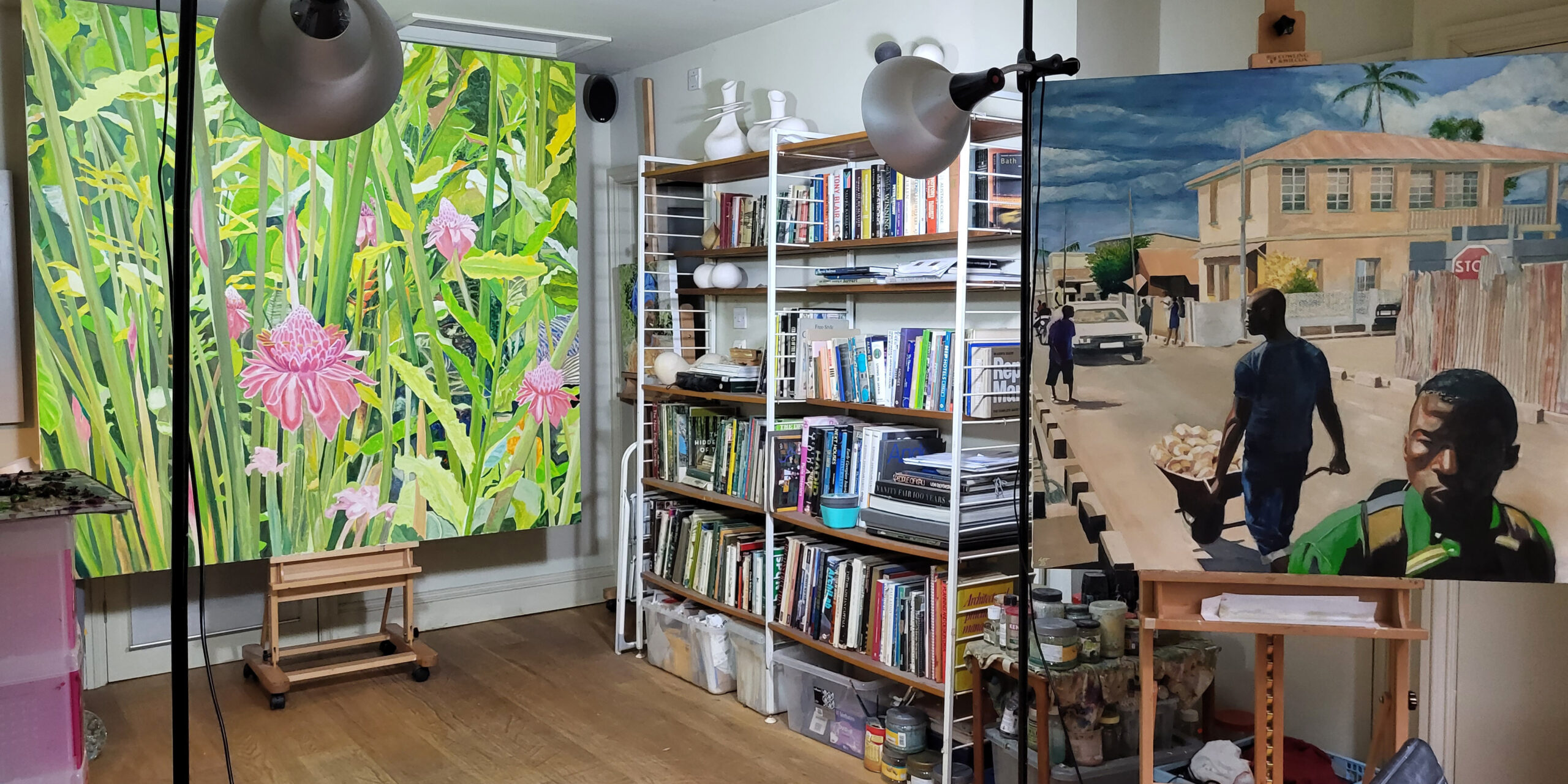Paintings born from memories and family albums are an ode to Sierra Leone in Arthur Timothy’s upcoming exhibit.
Postcards From A Promised Land is a window into Arthur Timothy’s relationship with the country he grew up in. Ghanaian on his mother’s side and Sierra Leonean on his father’s, he spent much of his childhood in Sierra Leone after his journalist father’s outspoken criticism of the Ghanaian government led to his deportation. Later, his father’s job took them to the U.K., but Timothy would continue to visit Sierra Leone once he had a family of his own. The artist’s memories and photographs taken on these visits – spanning from 1985 – would later become the basis of an exhibition at Gallery 1957, London.
Timothy’s painting work has deeply personal influences, exploring his family history. Portraits from past exhibitions feature relatives such as his mother’s sisters and father, some of whom he has never met but who exist in his mind, painted by stories told by other family members. When his father died, he left a wealth of images and writings that revealed much about the colonial period. “I really wanted to investigate that period through my paintings because a lot of it is actually unknown, certainly to a Western audience. To me, it overthrew the kind of perceptions that many people in the West had about Africa at that time,” he tells me.
Unlike his previous collections, which focus on portraiture, Postcards From A Promised Land also spotlights Sierra Leone’s stunning, tropical environment. “About six months of the year, you have this rain season where the rains are very heavy.” This feeds flora and fauna but also “takes its toll on the buildings.” Sometimes, people in the diaspora send money back to build houses, occasionally leaving unfinished buildings. Often, when he’d go back to Sierra Leone, Timothy would notice these abandoned structures overgrown with vegetation. “The nature is so abundant that it reclaims these buildings,” he muses.
The vibrant color palette of his paintings is not so much an artistic choice but a symptom of his subjects: the loud patterns of West African fashion and the lush environment of Sierra Leone. “If you go to a typical African market, you’ll be overwhelmed with color,” he explains. A triptych documents a family race on the beach where azure waters meet golden sands, while a painting of neighbors walking to church features a woman in a violet dress and matching hat. One image that holds particular meaning for him is that of his mother’s favorite flowers, which are known as porcelain roses (etlingera elatior) in a bright pink hue.
The title Promised Land is a reference to Sierra Leone’s history. Freetown, its capital, was founded as a settlement for freed African Americans, Afro-Caribbeans, and formerly enslaved Africans. Many were known as Black Loyalists – former slaves of African descent who sided with the British in the American War of Independence in exchange for freedom. This history is something the artist wanted to explore, owing to his relation on his father’s side to the Sierra Leone Creole people – a name given to the descendants of the formerly enslaved people who came back to Sierra Leone.
Despite the potential represented by the ‘promised land’s vivid natural beauty and mineral resources, Timothy talks about how through a “history of mismanagement and corruption, that promise has not been achieved.” Struggles like the aftermath of slavery, colonialism, Ebola, and a decade-long civil war have affected the region, as has political corruption. Politicians have a lot to answer for, says Timothy. When he returns for a holiday, he witnesses “the level of poverty, the natural beauty, all of the potential, and that there are some very wealthy people there.” But Timothy “can’t help but feel that it would take very little for there to be a more equitable distribution of wealth from the abundance of resources that the country has to offer.”
Timothy wanted to portray Sierra Leone with nuance and duality. Two of his paintings symbolize the country’s past devastation and future potential. As he explains in the exhibition’s press release, they demonstrate “the country’s sustained state of metamorphosis and the ongoing triumph of beauty over hardship.” A painting named Lakka features an unfinished structure abandoned during the country’s civil war and is meant to serve as a reminder of the disruption and unfulfilled dreams of this tumultuous time. On the other hand, Genesis is a painting of Timothy’s childhood home, now in the hands of his son, musician Duval Timothy, and represents hope for what the new generation can do for the country.
“There are some really good signs that people are beginning to take things into their own hands. There are a lot of young people who are now going back, who want to be in Sierra Leone and are contributing in any way that they can,” says Timothy.
Postcards From A Promised Land, at Gallery 1957 from December 8th 2022- 28th January 2023.





